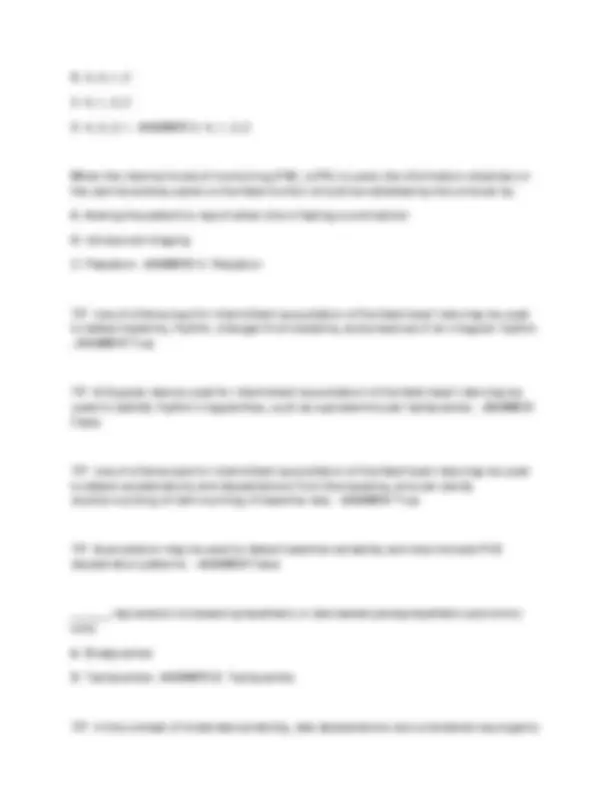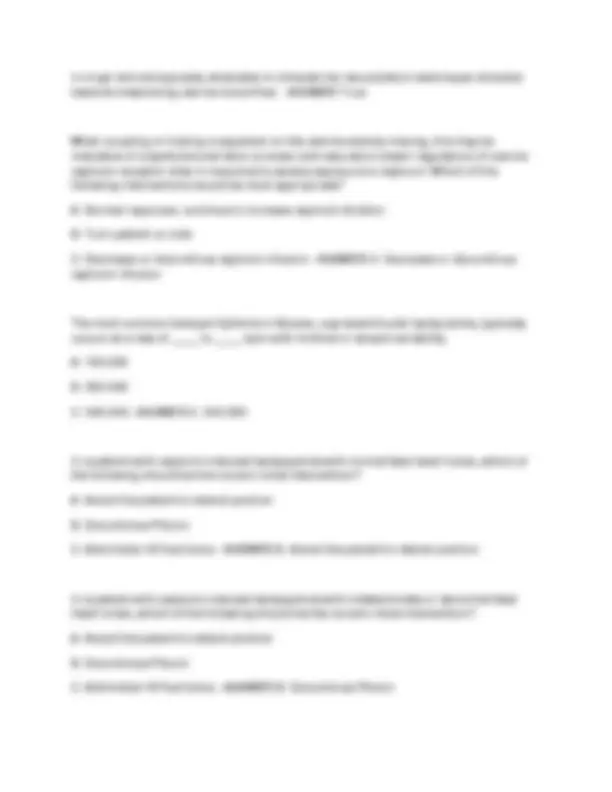






















































































Study with the several resources on Docsity

Earn points by helping other students or get them with a premium plan


Prepare for your exams
Study with the several resources on Docsity

Earn points to download
Earn points by helping other students or get them with a premium plan
Community
Ask the community for help and clear up your study doubts
Discover the best universities in your country according to Docsity users
Free resources
Download our free guides on studying techniques, anxiety management strategies, and thesis advice from Docsity tutors
NCC EFM CERTIFICATION EXAM WITH CORRECT ANSWERS 100% VERIFIED!!
Typology: Exams
1 / 92

This page cannot be seen from the preview
Don't miss anything!





















































































Which of the following factors can have a negative effect on uterine blood flow? a. Hypertension b. Epidural c. Hemorrhage d. Diabetes e. All of the above - ANSWER e. All of the above
How does the fetus compensate for decreased maternal circulating volume? a. Increases cardiac output by increasing stroke volume. b. Increases cardiac output by increasing it's heart rate. c. Increases cardiac output by increasing fetal movement. - ANSWER b. Increases cardiac output by increasing it's heart rate.
Stimulating the vagus nerve typically produces: a. A decrease in the heart rate b. An increase in the heart rate c. An increase in stroke volume d. No change - ANSWER a. A decrease in the heart rate
What initially causes a chemoreceptor response? a. Epidurals b. Supine maternal position c. Increased CO2 levels
d. Decreased O2 levels e. A & C f. A & B g. C & D - ANSWER g. C & D
The vagus nerve begins maturation 26 to 28 weeks. Its dominance results in what effect to the FHR baseline? a. Increases baseline b. Decreases baseline - ANSWER b. Decreases baseline
T/F: Oxygen exchange in the placenta takes place in the intervillous space. - ANSWER True
T/F: The parasympathetic nervous system is a cardioaccelerator. - ANSWER False
T/F: Baroreceptors are stretch receptors which respond to increases or decreases in blood pressure. - ANSWER True
T/F: There are two electronic fetal monitoring methods of obtaining the fetal heart rate: the ultrasound transducer and the fetal spiral electrode. - ANSWER True
T/F: Variability can be determined with the fetoscope. - ANSWER False
T/F: Because the ultrasound transducer and toco transducer are sealed units, they can be dipped in warm water to make cleaning easier. - ANSWER False
T/F: The most common artifact with the ultrasound transducer system for fetal heart rate is increased variability. - ANSWER True
T/F: The internal spiral electrode may pick up the maternal heart rate if the baby has died. - ANSWER True
T/F: Fetal arrhythmias can be seen on both internal and external monitor tracings. - ANSWER True
T/F: Variability and periodic changes can be detected with both internal and external monitoring. - ANSWER True
T/F: Variable decelerations are a result of cord compression. - ANSWER True
T/F: The presence of FHR accelerations in the intrapartum and antepartum periods is a sign of adequate fetal oxygenation. - ANSWER True
T/F: Variable decelerations are a vagal response. - ANSWER True
T/F: Late decelerations have a gradual decrease in FHR (onset to nadir 30 seconds) and are delayed in timing with the nadir of the deceleration occurring after the peak of the contraction. - ANSWER True
T/F: The fetal heart rate baseline can be determined during periods of marked variability. - ANSWER False
T/F: Anything that affects maternal blood flow (cardiac output) can affect the blood flow through the placenta. - ANSWER True
T/F: Variable decelerations are the most frequently seen fetal heart rate deceleration pattern in labor. - ANSWER True
T/F: Minimal variability is always an indicator of hypoxia and a Cesarean section is indicated. - ANSWER False
What is your first intervention in management of a patient experiencing variable decelerations? a. Immediate delivery b. Change maternal position c. No treatment indicated d. Oxygen e. Stop oxytocin infusion - ANSWER b. Change maternal position
Etiology of a baseline FHR of 165bpm occurring for the last hour can be:
What is the most probable cause of recurrent late decelerations? a. Utero-placental insufficiency b. Head compression c. Cord compression d. Maternal position change - ANSWER a. Utero-placental insufficiency
The most prevalent risk factor associated with fetal death before the onset of labor is: a. Low socioeconomic status b. Fetal malpresentation
If a nonstress test is nonreactive after 40 minutes, the next step should be: a. Have the client go home and do fetal movement counts b. Do a biophysical profile or contraction stress test c. Repeat the nonstress test within a week d. Admit the client for delivery - ANSWER b. Do a biophysical profile or contraction stress test
All of the following are components of a biophysical profile except: a. Contraction stress test b. Assessment of fetal breathing c. Amniotic fluid volume measurement d. Fetal movement assessment - ANSWER a. Contraction stress test
A modified biophysical profile includes a nonstress test and: a. Contraction stress test b. Ultrasound assessment of fetal movement c. Ultrasound assessment of amniotic fluid volume d. Fetal movement counts - ANSWER c. Ultrasound assessment of amniotic fluid volume
For a contraction stress test to be interpretable, you must have a minimum of: a. 5 contractions in a 10-minute window b. 3 contractions in a 10-minute window c. 4 contractions in a 10-minute window d. 2 contractions in a 10-minute window - ANSWER b. 3 contractions in a 10 minute window
A negative contraction stress test is one in which:
a. No contractions are seen b. There are late decelerations with > 50% of the contractions seen c. There are no fetal heart rate late decelerations with the contractions d. There is one fetal heart rate deceleration seen - ANSWER c. There are no fetal heart rate late decelerations with the contractions
According to AWHONN, the normal baseline Fetal Heart Rate (FHR) is A. 90-150 bpm B. 100-170 bpm C. 110-160 bpm D. 120-140 bpm - ANSWER C. 110-160 bpm
What are the two most important characteristics of the FHR? A. Rate and decelerations B. Variability and accelerations C. Variability and decelerations D. Rate and variability - ANSWER B. Variability and accelerations
You recognize that an FHR tracing has been showing a decrease in variability for the last 45 minutes. Your first intervention should be to A. Encourage ambulation B. Administer oxygen C. Discontinue IV fluids D. Increase Pitocin rate - ANSWER B. Administer oxygen
Resuscitation measures improves the baby's variability, but the FHR is still not reactive. You attempt fetal scalp stimulation (FSE) because you know that a well-oxygenated fetus will respond to FSE with a(n) A. Acceleration
T/F: Contractions cause an increase in uterine venous pressure and a decrease in uterine artery perfusion. - ANSWER True
As a result of the intrinsic fetal response to oxygen deprivation, increased catecholamine levels cause the peripheral blood flow to decrease while the blood flow to vital organs increases. These flow changes along with increased catecholamine secretions have what effect on fetal blood pressure and fetal heart rate? A. Increase BP and increase HR B. Increase BP and decrease HR C. Decrease BP and increase HR D. Decrease BP and decrease HR - ANSWER B. Increase BP and decrease HR
All of the following might indicate a pseudosinusoidal pattern as opposed to a sinusoidal pattern, except: A. Recent administration of narcotics to mother B. Accelerations in FHR C. Moderate variability D. Frequency of oscillations of two to five cycles/min - ANSWER D. Frequency of oscillations of two to five cycles/min
All of the following are appropriate interventions for fetal tachycardia except: A. Increase maternal IV fluid rate B. Assess maternal vital signs C. Perform SVE D. Administer oxygen - ANSWER C. Perform SVE
During a term antepartum NST (non-stress test), you notice several variable decelerations that decrease at least 15 bpm and last at least 15 sec long. Which of the following is the least likely explanation?
A. True knot B. Gestational diabetes C. Umbilical cord entanglement D. Oligohydramnios - ANSWER B. Gestational diabetes
All of the following are likely causes of prolonged decelerations except: A. Uterine tachysystole B. Prolapsed cord C. Maternal hypotension D. Maternal fever - ANSWER D. Maternal fever
_______ decelerations occur with less than 50% of contractions. A. Recurrent B. Intermittent C. Repetitive - ANSWER B. Intermittent
_______ decelerations occur with greater than or equal to 50% of contractions. A. Recurrent B. Intermittent C. Repetitive - ANSWER A. Recurrent
All of the following could likely cause minimal variability in FHR except A. Magnesium sulfate administration B. Fetal sleep cycle C. Narcotic administration D. Ephedrine administration - ANSWER D. Ephedrine administration
Before ___ weeks of gestation, an increase in FHR that peaks at least 10 bpm above the baseline and lasts at least 10 seconds is considered an acceleration. A. 28 B. 30 C. 32 D. 36 - ANSWER C. 32
The expected response of the fetal heart rate to active fetal movement of a 31-week gestational age fetus is: a. Suppression of normal short term variability for 15 seconds b. Acceleration of at least 15 beats per minute for 15 seconds c. Acceleration followed by a 15-second deceleration of the heart rate d. Acceleration of at least 10 beats per minute for 10 seconds - ANSWER d. Acceleration of at least 10 beats per minute for 10 seconds
The nurse notes a pattern of variable decelerations to 75 bpm on the fetal monitor. The initial nursing action is to: a. Reposition the woman b. Administer oxygen c. Increase the intravenous fluid infusion d. Stimulate the fetal scalp - ANSWER a. Reposition the woman
The tocotransducer should be placed: a. In the suprapubic area b. In the fundal area c. Over the xiphoid process d. Within the uterus - ANSWER b. In the fundal area
The nurse notes a pattern of decelerations on the fetal monitor that begins shortly after the contraction and returns to baseline just before the contraction is over. The correct nursing response is to: a. Give the woman oxygen by facemask at 8-10 L/min b. Position the woman on her opposite side c. Increase the rate of the woman's intravenous fluid d. Continue to observe and record the normal pattern - ANSWER d. Continue to observe and record the normal pattern
Determining the FHR baseline requires the nurse to approximate the mean FHR rounded to increments of 5 bpm during a ___-minute window (excluding accelerations and decelerations). A. 2 B. 5 C. 10 D. 20 - ANSWER C. 10
Uterine tachysystole is observed when there are A. 5 or more contractions in 10 min B. 6 or more contractions in 10 min C. 10 or more contractions in 10 min D. 7 or more contractions in 10 min - ANSWER B. 6 or more contractions in 10 min
Which of the following interventions would best stimulate an acceleration in the FHR? A. Provide juice to patient B. Perform vaginal exam C. Turn patient on left side D. Vibroacoustic stimulation - ANSWER B. Perform vaginal exam
A. Patient report B. Tocodynanamometer tracing C. RN palpation D. Sterile vaginal exam during a contraction - ANSWER C. RN palpation
The FHR is controlled by the A. Sympathetic nervous system B. Sinoatrial node C. Atrioventricular node D. Parasympathetic nervous system - ANSWER B. Sinoatrial node
How do baseline heart rates differ in premature fetuses? A. They are often lower B. They are often higher C. They are less likely to have decelerations D. They experience longer accelerations - ANSWER B. They are often higher
T/F: If etiology of fetal tachycardia is secondary to extrauterine infection, FHR will return to normal as maternal fever resolves. - ANSWER True
T/F: Fetal tachycardia is a normal compensatory response to transient fetal hypoxemia. - ANSWER True
Fetal heart rate bradycardia is defined as A. FHR <110bpm lasting 10 min or greater B. FHR <110bpm lasting 2 min or greater C. FHR <110bpm lasting 20 min or greater - ANSWER A. FHR <110bpm lasting 10 min or greater
_______ variability warrants cesarean section delivery. A. Minimal B. Moderate C. Marked D. Absent - ANSWER D. Absent
At how many weeks gestation should FHR variability be normal in manner? A. 24 weeks B. 28 weeks C. 32 weeks D. 36 weeks - ANSWER B. 28 weeks
A deceleration from 145bpm down to 100bpm lasting 12 minutes may be defined as a A. Prolonged deceleration B. Variable deceleration C. Late deceleration D. Baseline change - ANSWER D. Baseline change
Reduced respiratory gas exchange from persistent decelerations may cause a rise in fetal PCO2, which leads first to _______ _______, then _______ _______. A. Respiratory alkalosis; metabolic acidosis B. Respiratory acidosis; metabolic acidosis C. Respiratory alkalosis; metabolic alkalosis D. Respiratory acidosis; metabolic acidosis - ANSWER B. Respiratory acidosis; metabolic acidosis
Decreased intervillious exchange of oxygenated blood resulting in fetal hypoxia is
FHTs with absent variability and bradycardia would be categorized as A. Category I B. Category II C. Category III - ANSWER C. Category III
FHTs with moderate variability, no accelerations, and early decelerations would be categorized as A. Category I B. Category II C. Category III - ANSWER A. Category I
FHTs with accelerations, no decelerations, and minimal variability would be categorized as A. Category I B. Category II C. Category III - ANSWER B. Category II
Sinusoidal pattern is categorized as A. Category I B. Category II C. Category III - ANSWER B. Category III
FHTs with absent variability and no accelerations or decelerations would be categorized as A. Category I B. Category II C. Category III - ANSWER B. Category II
Absence of accelerations following fetal stimulation (i.e. scalp stimulation) is categorized as A. Category I B. Category II C. Category III - ANSWER B. Category II
FHTs with minimal variability, absent accelerations, and a 3-minute prolonged deceleration would be categorized as A. Category I B. Category II C. Category III - ANSWER B. Category II
FHTs with minimal variability and a baseline of 95bpm would be categorized as A. Category I B. Category II C. Category III - ANSWER B. Category II
FHTs with a baseline of 170bpm, moderate variability, and no accelerations or decelerations would be categorized as A. Category I B. Category II C. Category III - ANSWER B. Category II
FHTs with a baseline 135bpm, moderate variability, accelerations, and one late deceleration would be categorized as A. Category I B. Category II C. Category III - ANSWER B. Category II